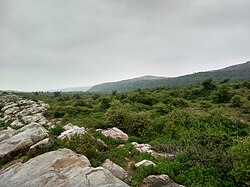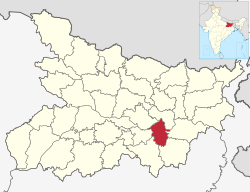Munger_district
Munger district
District of Bihar in India
Munger district is one of the thirty-eight districts of Bihar state in eastern India. The city of Munger is the administrative headquarters of this district. The district is a part of Munger Division. Its literacy rate of 73.3% is higher than the state literacy rate of 63.8%, but lower than national rate of 74.04%.
This article needs additional citations for verification. (January 2017) |
Munger district | |
|---|---|
 Hills near Jamalpur | |
 Location of Munger district in Bihar | |
| Country | India |
| State | Bihar |
| Division | Munger |
| Established | 3 December 1834 |
| Headquarters | Munger |
| Government | |
| • Lok Sabha constituencies | Munger |
| • Vidhan Sabha constituencies | Tarapur, Jamalpur and Munger |
| Area | |
| • Total | 1,419.7 km2 (548.1 sq mi) |
| Population (2011) | |
| • Total | 1,367,765 |
| • Density | 960/km2 (2,500/sq mi) |
| Demographics | |
| • Literacy | 73.30 per cent |
| • Sex ratio | 879 |
| Time zone | UTC+5:30 (IST) |
| PIN | 811201 to 811214 , 813201 |
| Telephone code | +91-6344 ; +91-6342 |
| Vehicle registration | BR-08 |
| Major highways | NH-33, NH-333 , NH-333B |
| Average annual precipitation | 1146 mm |
| Website | munger |
The present collector and District Magistrate of Munger is Avaneesh Kumar Singh , IAS. Rajeev Rajan Singh Urf Lalan Singh is the district's MP.
Munger has seen five districts partitioned off from its territory: Begusarai in 1972;[1] Khagaria in 1988;[1] and Jamui in 1991;[2] and Lakhisarai district and Sheikhpura in 1994.[3][4]
Munger, along with Jamalpur are the major industrial cities in Bihar.[5] Munger is also one of the most prosperous cities in Bihar with a per capita income of INR 42,793 in FY 2020-21. [6]
Munger District is located in the southern part of Bihar and its headquarters is located on the southern bank of river Ganges. Munger district occupies an area of 1,419 square kilometres (548 sq mi),[7]
Flora and fauna
In 1976, Munger district became home to the Bhimbandh Wildlife Sanctuary, which has an area of 682 km2 (263.3 sq mi).[8] comparatively equivalent to Russia's Urup Island.[9]
| Year | Pop. | ±% |
|---|---|---|
| 1901 | 339,678 | — |
| 1911 | 350,312 | +3.1% |
| 1921 | 333,110 | −4.9% |
| 1931 | 375,095 | +12.6% |
| 1941 | 424,049 | +13.1% |
| 1951 | 468,646 | +10.5% |
| 1961 | 555,833 | +18.6% |
| 1971 | 657,390 | +18.3% |
| 1981 | 801,071 | +21.9% |
| 1991 | 943,583 | +17.8% |
| 2001 | 1,137,797 | +20.6% |
| 2011 | 1,367,765 | +20.2% |
| Source: Census of India[10] | ||
| Religions in Munger district (2011)[11] | ||||
|---|---|---|---|---|
| Religion | Percent | |||
| Hinduism | 91.56% | |||
| Islam | 8.07% | |||
| Other or not stated | 0.37% | |||
According to the 2011 census Munger district has a population of 1,367,765,[12] roughly equal to the nation of Eswatini[13] or the US state of Hawaii.[14] This gives it a ranking of 358th in India (out of a total of 640).[12] The district has a population density of 958 inhabitants per square kilometre (2,480/sq mi) .[12] Its population growth rate over the decade 2001-2011 was 19.45%.[12] Munger has a sex ratio of 879 females for every 1000 males,[12] and a literacy rate of 73.3%. 27.79% of the population lives in urban areas. Scheduled Castes and Scheduled Tribes make up 13.44% and 1.56% of the population respectively.[12]
Languages
At the time of the 2011 Census of India, 61.76% of the population in the district spoke Hindi, 6.10% Urdu and 0.93% Santali as their first language. 30.56% of the population spoke languages classified as 'Others' under Hindi in the census.[15] The local language is Angika, sometimes classified as a Maithili dialect.[16]
| District | No. | Constituency | Name | Party | Alliance | Remarks | ||
|---|---|---|---|---|---|---|---|---|
| Munger | 164 | Tarapur | Mewa Lal Choudhary | JD(U) | NDA | Died on 19 April 2021 due to COVID-19 | ||
| Rajeev Kumar Singh | Elected on 2 November 2021 in by-election | |||||||
| 165 | Munger | Pranav Kumar Yadav | BJP | NDA | ||||
| 166 | Jamalpur | Ajay Kumar Singh | INC | MGB | ||||
The Munger district has three sub-divisions and ten blocks and anchal (posts).[17]
| Sub-divisions | Blocks and anchal |
|---|---|
| Munger Sadar | Sadar, Jamalpur, Bariarpur, Dharhara |
| Haveli Kharagpur | Haveli Kharagpur, Tetiyabambar |
| Tarapur | Tarapur, Sangrampur, Asarganj |
In 2006, the Ministry of Panchayati Raj named Munger one of the country's 250 most backward districts (out of a total of 640).[18] It is one of the 36 districts in Bihar have been receiving funds from the Backward Regions Grant Fund Programme (BRGF).[18]
Munger has many historically popular destinations that are visited by tourists all year round.
Chandika Temple
The Chandika Sthan temple where Sati is worshiped. The legend says that the left eye of Maa Sati fell at Munger, which subsequently developed into a place of worship of the Divine Mother Chandi.
Bihar School of Yoga
Bihar School of Yoga also known as Bihar Yoga Bharati was established in 1963. It is dedicated to the study of yoga in an ashram environment, providing a spiritual oasis in the material and technological desert of the 21st century. Bihar Yoga Bharati (BYB), an Institute for Advanced Studies in Yogic Sciences, is the first of its kind in the world wholly devoted to the subject of yoga.
Munger Fort
Munger Fort is an almost two thousand-year-old fort tracing back to Chandragupta Maurya period. During the British raj it was occupied by the British. The story of Monghyr Mutiny is well known among the locals.
Pir Shah Nafah Shrine
The tomb of Pir Shah Nafah Shrine is a sacred Muhammdan shrine built on an elevated piece of ground near the southern gate of the Munger Fort. It is said that it was a mazaar of a Pir or Saint whose name is still unknown. He is said to have travelled from Persia to Ajmer and from there came down to Munger under the instructions from Khwaza Moin-Uddin Chisti.
Kastaharani Ghaat
Kastaharani Ghaat traces its origin back to Ramayana. It is believed that on his return journey from Mithila to Ayodhya after marrying Sita, Rama and company took a dip in this water to relieve themselves from fatigue (kasta) and hence the name Kastaharani (reliever of stress).
- Law, Gwillim (25 September 2011). "Districts of India". Statoids. Retrieved 11 October 2011.
- "Welcome To District Jamui,(Bihar) Website". jamui.bih.nic.in. Archived from the original on 18 August 2011. Retrieved 6 July 2016.
- "Welcome To District Lakhisarai,(Bihar) Website". lakhisarai.bih.nic.in. Retrieved 6 July 2016.
- "This is the official website of District Administration of Sheikhpura, State Government of Bihar(India)". sheikhpura.bih.nic.in. Retrieved 6 July 2016.
- "About Hajipur, General Information on Hajipur, Hajipur Profile". www.HajipurOnline.in. Archived from the original on 19 October 2015. Retrieved 26 October 2017.
- "Patna, Begusarai, Munger emerge most prosperous districts of Bihar". The Statesman. 27 February 2023.
- Srivastava; Dayawanti; et al., eds. (2010). "States and Union Territories: Bihar: Government". India 2010: A Reference Annual (54th ed.). New Delhi, India: Additional Director General, Publications Division, Ministry of Information and Broadcasting (India), Government of India. pp. 1118–1119. ISBN 978-81-230-1617-7.
- Indian Ministry of Forests and Environment. "Protected areas: Bihar". Archived from the original on 23 August 2011. Retrieved 25 September 2011.
- "Island Directory Tables: Islands by Land Area". United Nations Environment Program. 18 February 1998. Retrieved 11 October 2011.
Urup 1,436km2
- "Table C-01 Population by Religion: Bihar". censusindia.gov.in. Registrar General and Census Commissioner of India. 2011.
- US Directorate of Intelligence. "Country Comparison:Population". Archived from the original on 13 June 2007. Retrieved 1 October 2011.
Swaziland 1,370,424
- "2010 Resident Population Data". U. S. Census Bureau. Retrieved 30 September 2011.
Hawaii 1,360,301
- "Table C-16 Population by Mother Tongue: Bihar". censusindia.gov.in. Registrar General and Census Commissioner of India. 2011.
- "52nd Report of the Commissioner for Linguistic Minorities in India" (PDF). nclm.nic.in. Ministry of Minority Affairs. Archived from the original (PDF) on 25 May 2017. Retrieved 22 January 2019.
- "Subdivision & Blocks | Munger District, Government of Bihar | India". Retrieved 7 January 2024.
- Ministry of Panchayati Raj (8 September 2009). "A Note on the Backward Regions Grant Fund Programme" (PDF). National Institute of Rural Development. Archived from the original (PDF) on 5 April 2012. Retrieved 27 September 2011.